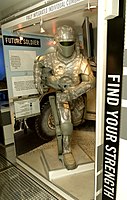
Photo from wikipedia
Exoskeleton robots have demonstrated the potential to rehabilitate stroke dyskinesia. Unfortunately, poor human-machine physiological coupling causes unexpected damage to human of muscles and joints. Moreover, inferior humanoid kinematics control would… Click to show full abstract
Exoskeleton robots have demonstrated the potential to rehabilitate stroke dyskinesia. Unfortunately, poor human-machine physiological coupling causes unexpected damage to human of muscles and joints. Moreover, inferior humanoid kinematics control would restrict human natural kinematics. Failing to deal with these problems results in bottlenecks and hinders its application. In this paper, the simplified muscle model and muscle-liked kinematics model were proposed, based on which a soft wrist exoskeleton was established to realize natural human interaction. Firstly, we simplified the redundant muscular system related to the wrist joint from ten muscles to four, so as to realize the human-robot physiological coupling. Then, according to the above human-like musculoskeletal model, the humanoid distributed kinematics control was established to achieve the two DOFs coupling kinematics of the wrist. The results show that the wearer of an exoskeleton could reduce muscle activation and joint force by 43.3% and 35.6%, respectively. Additionally, the humanoid motion trajectories similarity of the robot reached 91.5%. Stroke patients could recover 90.3% of natural motion ability to satisfy for most daily activities. This work provides a fundamental understanding on human-machine physiological coupling and humanoid kinematics control of the exoskeleton robots for reducing the post-stroke complications.
Journal Title: Journal of Bionic Engineering
Year Published: 2020
Link to full text (if available)
Share on Social Media: Sign Up to like & get
recommendations!